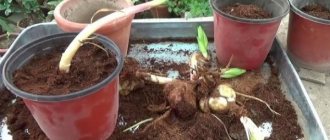The perennial calla flower, which many consider to be a houseplant, thrives in open ground and decorates many garden areas. Unfortunately, this plant is not resistant to cold weather and cannot overwinter in the ground. Therefore, flower growers dig up these flowers for the winter. But in order to see flowering next year, you need to know how to store callas in winter at home. We'll talk about this today.
Selection of planting material
A high-quality, healthy tuber is the key to the normal development of the plant. Therefore, the choice of planting material must be approached very responsibly. The tuber should not be soft or show signs of disease or mechanical damage.
The size of the tubers plays an equally important role. The larger they are, the faster flowering will begin, and the more inflorescences there will be. The number of inflorescences in a plant with a large tuber can exceed 20 pieces.
Before planting in the soil, the tubers are washed in a weak solution of potassium permanganate, then rinsed with clean water and dried.
Preparation
In order for the wintering of plants to be successful, they should be dug out of the soil at a certain time. Harvesting tubers too early will lead to the fact that the plant, whose growing season has not yet ended, will not be able to survive wintering normally. And if you wait until severe frosts to dig it up, the flower may die from the cold.
In the climate of the middle zone, calla lily tubers are collected with the onset of the first night frosts (the first days of October). And in more southern areas this can be done a month later: in early November.
With the arrival of the first frost, plants need to be pruned. Dry leaves are cut so that they are visible 5-7 cm above the ground.
You should dig up the rhizomes very carefully, using a garden fork, so as not to harm the plants. The flower is dug up at a safe distance from the roots, after which it is pryed up with a pitchfork along with a lump of earth.
Root tubers need to be cleared of soil residues. To do this, they are placed in a container with water, after which they are gently washed under a small running stream.
When the tubers are cleaned, they are carefully inspected. Planting material that has damage, rotten areas and signs of disease is discarded.
Small damaged areas can be removed with a sharp knife, and then treated with brilliant green or crushed coal.
Drying the tubers
The next stage of preparation is drying the tubers. This should be done in places with good ventilation, away from sunlight. In such places it is necessary to maintain a constant temperature within +20°C - +25°C.
Drying of planting material should continue for at least 2 - 3 weeks , after which calla lilies can be stored all winter.
Remnants of dry leaves must be completely removed from the tubers. This is done a few days after the start of storage. After which, after about a week, the roots are removed. By this time, the roots will separate easily. This must be done so that the flower does not begin to grow prematurely without spending enough time in “cool dormancy.”
During this period, small tubers (babies) have not yet formed a special film that allows them to “live independently.” Therefore, it is impossible to separate them from the mother tubers. This should be done in winter, when they are already stronger. Then it will be a full-fledged planting material.
If the babies were separated from the tubers ahead of time and were damaged, they can be treated with brilliant green (coal dust) and dried. Calla lily bulbs should be stored in winter until the last days of March.
How to dig up callas correctly?
The time for this technological operation is after the first frost, approximately:
- early October in the middle zone,
- early November - in more southern regions.
There is no need to be afraid that the first small frosts will damage the plant. On the contrary, this will be a signal for him about the end of the vegetative period. The plant will stop using nutrients to produce leaves as it begins to prepare for dormancy.
Before digging up calla lilies, you need to prepare the plant. To do this, stop watering it if the weather is dry, about 2-3 weeks before the expected harvest for the winter. This advice is relevant for the southern regions, where a dry climate in the fall is far from uncommon. Before digging, you need to cut the calla lilies leaves above the soil level by about 7-8 cm. After the first frost, the foliage has already dried out, and this operation is easy to carry out with ordinary scissors.
Advice
It is best to dig up calla lilies with a garden fork. This way there is less chance of damaging the delicate parts of the plant.
When digging calla lilies, it is advisable to leave a fairly large distance around their roots. It is better to play it safe and dig a hole of a larger diameter than to treat a plant injured by a shovel or pitchfork. After digging, you need to carefully remove the soil from its roots, being careful not to damage them. You can wash off the remaining soil with running water under a tap or a garden hose. Try not to let the stream be too strong. High water pressure can damage the “children” of calla lilies that have not yet separated from the adult plant.
Under what conditions should it be stored?
Conditions for storing calla lilies in winter are as follows:
- constant temperature within +5°C - +10°C;
- ensuring ventilation in places where planting material is stored;
- low level of humidity to prevent mold from forming;
- storing rhizomes at some distance from each other, sprinkled with sand, wood shavings or covered with moss and peat;
- regular inspection of planting material for timely identification of diseased tubers.
The container in which the rhizomes are located can be placed on an insulated balcony, in a cellar, basement, cool pantry, or refrigerator.
In the basement
Storing calla lilies at home is best done in drawers, in a basement or cellar. Good ventilation and constant temperature are a must. The optimal storage temperature for calla lilies is +5°C - +10°C.
If the room is warmer, the tubers may begin to germinate prematurely, so maintaining the correct temperature is very important. The air should also not be too humid. The development of fungus in this case will destroy the tubers. Therefore, calla lilies can only be preserved in a dry room in winter.
Garden callas description
It is a mistake to consider calla lilies exclusively as indoor plants. This opinion is refuted by garden species, which can grow well in open ground if they are provided with optimal conditions. And it is quite possible to implement this idea, even despite the fact that the homeland of this representative of the aroid family is the tropics of South Africa.
An interesting fact is that under natural conditions, calla lilies bloom only in warm winters. In our climate, these plants will feel good in gardens at any time of the year, fully demonstrating their decorative properties in spring and summer. If you are familiar with the rules for growing dahlias, then you probably won’t have any big problems with callas. Although dahlias seem to be one of the traditional plants for domestic gardeners, calla lilies, which are also known as callas, are a rarity in the area.
A clue when to dig up callas in the fall will be the yellowed leaves of the flower. This means that their biological cycle has come to an end. In order not to miss the moment, the period is marked on the calendar when it is allowed to dig up calla bulbs. The time comes at the end of September, as soon as there is a threat of frost.
In the apartment
When there are no other options, you can store calla tubers in a city apartment in winter. To do this, boxes with planting material are placed in the coolest places. A vestibule, a pantry, a place near the balcony door, etc. are best suited.
To prevent the tubers from drying out and shriveling, they should be kept as far as possible from hot radiators and other heat sources. Even if planting material that has been exposed to temperatures above +20°C can maintain viability, flowering will not be as abundant as we would like. If the warm place is also damp, the flowers will quickly begin to sprout.
Do you need to dig up callas in the fall, and when to do it?
In the same central zone (Moscow region), callas will not be able to overwinter in the ground with any shelter, so they should be dug up in time and stored in a cool place for the winter.
As for the timing, it is imperative to dig up calla lily tubers before frosts and autumn rains . This is around October, when the leaves are already starting to turn yellow .
Note! If the leaves are still green , then you should still dig up the tubers. But don't cut off the leaves yet!
The fact is that in cold and wet soil the tubers can rot , so it is better to dig them up early .
Step-by-step instructions for digging calla lilies:
- Carefully dig around the bush from all sides and pull it out along with the earthen lump.
Advice! Under no circumstances should you pull on the leaves, otherwise you can simply tear out the leaves, and the tubers will remain in the ground.
- Next, if desired, rinse the tubers or shake them off the ground so that they are clean (but you can do this a little later), and then put them in a relatively warm place to dry (on newspapers in boxes).
- Wait until the leaves turn completely yellow and dry (= transfer nutrition to the tubers), separate the tubers from the roots.
If the tubers separate poorly, then you need to continue “drying”.
- That’s it, you can put calla lily tubers for winter storage.
If desired, before storing, you can treat the tubers in any fungicide (for example, Maxim) to disinfect them. And then dry well.
Flowers in pots
How to store calla bulbs, if they are indoor plants, worries many housewives. After all, these flowers also require a period of rest.
When flowering is finished, containers with callas are placed in a dark place with a low temperature so that their growing season ends faster. In this case, watering the plants should be reduced to a minimum.
You can store tubers of indoor calla lilies in winter directly in pots. Or you can dig up the bulbs, carry out the treatment as indicated above, and keep them in the general conditions for this plant.
Excavation time and preparation for storage
They begin to dig up tubers of garden callas from the end of September, when there is a threat of frost. At this time, they are already completing their biological cycle, their foliage begins to turn yellow.
After digging, the callas are laid out for further drying for 10 days, while all leaves and roots must be left on the plants.
After this time, the tubers are carefully cleaned of any remaining soil; it is very important not to damage the young tubers and children.
Attention! There is no need to separate the babies now; during winter storage they will ripen and in the spring they will easily separate from the mother plant.
After cleaning the tubers from the ground, you can begin to remove dry leaves and remaining roots. It is very important to trim the roots; if left, the plants may soon begin to grow.
Now the peeled tubers must be dried at a temperature of about 25° for 2 weeks. Only after this can they be placed for further storage.
Premature growth
When one of the tubers begins to germinate ahead of schedule, it is planted in the soil and grown in a pot as an indoor flower. And with the arrival of spring warmth, it is transplanted into open ground. After which the calla lily will again become a garden plant.
To ensure that calla lilies bloom as early and luxuriant as possible, the tubers of this plant should be dug up every autumn at a certain time and stored in proper conditions. And those who decide to leave them in the soil may be left without this beauty in the new season.
Storing callas in winter is not at all difficult, you just need to follow the tips given in this article.
How do tubers winter?
It is very important to check each root for damage and rot. When answering the question of how to store callas in winter, experienced gardeners focus on the integrity of the tubers. If black specks appear, they must be scraped off with a special tool or a regular teaspoon. After which the tuber is left for 2-3 hours so that the damaged areas dry out slightly. Then each “scratch” must be treated with brilliant green or crushed activated carbon. The same is done when you need to break the mother root and separate the children. After the procedure, the tubers are wrapped in paper napkins and stored in this form in cardboard boxes. Sometimes you need to check the planting material to see if it has acquired a new infection or rot. But with proper processing, such “complications” should not arise.
The box is placed in a dry and fairly cool place; the container must have a loose lid. When deciding how to store callas in winter, you should not forget when to take them out in the spring. Fortunately, this method of keeping tubers allows the plant to remain viable for a long time until the time comes for planting on the site.











